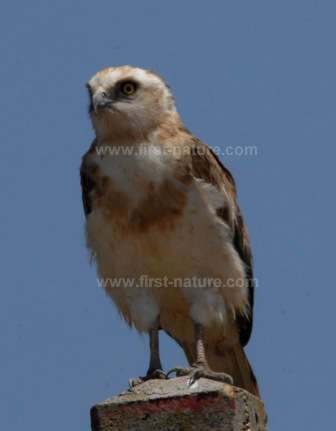Conservation
Articles Out with
Papa Figos Algarve
Books
Mountain Regions of the Algarve

The Short-toed Eagle is one of the bird species to look out for in the mountains of the Algarve. Picture: Ray Tipper Licence enquiry...
There are three mountain ranges in the Algarve: in the west are the Serra de Espinhaco de Cao, in the centre the Serra de Monchique, and further north (behind the town of Loule) the Serra de Caldeirao.
Of the three Serra de Monchique is the highest and consists of two 'massifs', Foia and Picotta. The underlying rock of these mountains is syenite which is relatively rare, and leads to a diversity of special wildlife habitats which are under consideration for Natura 2000 designation and protection.
All three of these mountain ranges offer excellent terrain for wildlife enthusiasts to explore and enjoy. Access to various walks in the mountain areas is easy from the main roads which run through them, and there are sufficient informal parking places along the routes at which you can leave your transport and set off for a hike.
The Serra de Espinhaco de Cao is a range of gentle hills which are best accessed from the 268 road between Odeceixe and Carapateira on the western coast of the Algarve.
The most easterly of the mountains run between Gomes Aires in the north and drop down almost as far as Loule in the south. The road (Route A2) that runs from Sao Bras de Alportel in the south to Castro Verde in the north has numerous stopping places where the curious can get out of their cars and explore the terrain which is largely wooded. It is an excellent route for those who are interested in fungi, and at the right time of year, you do not need to stray far from your vehicle to find them. This road is an excellent and very scenic route to take if you decide to visit the wonderful scenery of Parque Natural do Vale do Guadiana and the lovely little town of Mertola. It is very winding, steep and time-consuming but has much of interest to enjoy along the way.
A visit to Serra de Monchique in spring and early summer is well worthwhile if you are interested in wildflowers. It is one of the few sites where the rare baeticum subspecies of Rhododendron ponticum occurs, although many British visitors may be forgiven for thinking that they see quite enough of Rhodendron ponticum at home where it has become regarded as an invasive alien pest species which thrives at the expense of our native flora. There are, however, other interesting and rare species to be found in the hills that will take your mind off the rhododendrons: wild Peony (Paeonia broteroi) grows in the hills as do the rare Dense-flowered Orchid (Neotinea maculata) and the Early Purple Orchid (Orchis mascula), the latter being familiar to UK visitors.
Once above Monchique the drive up to the top of the mountains at Foia can be somewhat depressing as it winds through endless Eucalyptus plantations, but do persevere. Eventually the Eucalyptus gives way to open heathland which is where the majority of the wildflowers and other wildlife can be seen and enjoyed. Serra de Monchique is one of the last strongholds of the Iberian Lynx which has been driven to the point extinction in both Spain and Portugal as a result of habitat destruction. In the Algarve there are strenuous efforts being made to breed and reintroduce the Iberian Lynx to the area.
Birds to look out for up in these mountains include Great Spotted Woodpecker, Vultures and the Short-toed Eagle.
In the Walks section of this website we are working on providing a list of places to walk so that you can enjoy the various habitats of the Algarve, and the wonderful wildlife that inhabits them.
Sue Parker's latest ebook is a revised and enlarged second edition of the acclaimed Wildflowers in the Algarve - an introductory guide. Full details here...
Buy it for just £3.95 on Amazon...
Sue Parker's 5-star acclaimed field guide to the Wild Orchids of the Algarve is now available as an ebook. Full details here...
Buy it for just £5.95 on Amazon...
Please Help Us: If you have found this information interesting and useful, please consider helping to keep First Nature online by making a small donation towards the web hosting and internet costs.
Any donations over and above the essential running costs will help support the conservation work of Plantlife, the Rivers Trust and charitable botanic gardens - as do author royalties and publisher proceeds from books by Pat and Sue.